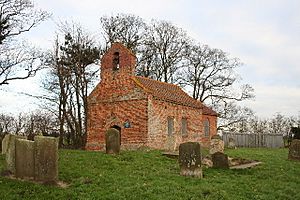St George's Church, Goltho facts for kids
Quick facts for kids St George's Church, Goltho |
|
|---|---|

St George's Church, Goltho, from the southwest
|
|
| Lua error in Module:Location_map at line 420: attempt to index field 'wikibase' (a nil value). | |
| OS grid reference | TF 116 775 |
| Location | Goltho, Lincolnshire |
| Country | England |
| Denomination | Anglican |
| Website | Churches Conservation Trust |
| History | |
| Dedication | Saint George |
| Architecture | |
| Functional status | Redundant |
| Heritage designation | Grade II* |
| Designated | 30 November 1966 |
| Architectural type | Church |
| Style | Gothic |
| Groundbreaking | c. 1530 |
| Specifications | |
| Materials | Brick, tiled roof |
St George's Church is an old Anglican church in the quiet, empty village of Goltho, Lincolnshire, England. It is no longer used for regular church services. This church is listed as a Grade II* building, which means it is very important historically and architecturally. The Churches Conservation Trust looks after it.
The church is in a field. You can only reach it by walking on footpaths. It is about 2 kilometers (1.2 miles) southwest of Wragby and 18 kilometers (11 miles) northeast of Lincoln. This church was the last building left from a deserted medieval village. This village and its land dated back to the 800s. Before that, there was even a Romano-British settlement here. Sadly, the church was badly damaged by fire in 2013.
History of the Church
The main part of the church, called the nave, was rebuilt around 1530. This was done by the Grantham family, who lived at Goltho Hall (which is now gone). The chancel, which is the area near the altar, was added around 1600. Some changes and additions were made in the early 1700s and again in the late 1800s.
On October 21, 2013, a fire completely destroyed the inside of the church. Only the walls and the small tower for the bell, called a bellcote, were left standing. Experts believe the fire was most likely caused by a lightning strike. The Churches Conservation Trust does not have insurance for its buildings. Because of this, the church has not been repaired since the fire. People are not allowed to go inside for safety reasons.
What the Church Looked Like
St George's Church was built with red bricks. It had a roof made of tiles with wooden eaves (the parts that hang over the walls). The church had a simple design. It had a nave with a bellcote at the west end. The chancel was narrower and a bit lower than the nave.
You entered the church through a door at the west end. Above this door was a window that had been filled in. The bellcote had one round opening for the bell. On the north side of the church, there was a small opening high on the wall. Further east, there was a large rectangular window. The north wall of the chancel had a big window with a pointed top. At the very east end, there was a round, oval window that was just for decoration. The south wall of the chancel had one large pointed window. There was also a big rectangular window in the south wall of the nave. Next to this window, you could see part of an arch from a doorway that had been blocked up.
Inside, the walls were painted white with a special coating called lime-wash. The church furniture was simple and painted a light blue color. There were special recessed areas, called niches, in the north and south walls of the nave. Two gravestones from the 1600s were part of the floor in the nave.
Many of the church's old fittings were destroyed in the fire. These included a tall, two-story pulpit (where the priest gives sermons). There was also a fancy screen behind the altar, called a reredos, from the Queen Anne period. The church had box pews, which are like small enclosed seating areas. The altar rails, which separate the altar from the rest of the church, were made of carved wood. There were also carved ends on the benches. At the west end of the nave, there was a small balcony, probably for singers or musicians.
The small size and charming simplicity of this church made it special. It was the last visible piece of the old village of Goltho. The famous English artist John Piper even drew it. This drawing was included in a collection of poems called Church Poems by the British Poet Laureate John Betjeman.
Outside the Church
In the churchyard, there is a war grave. It belongs to an officer from the Royal Air Force who died during the First World War.
See also

